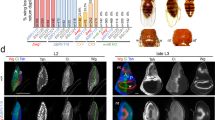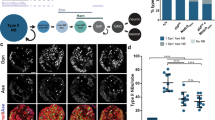Abstract
DURING embryogenesis, body pattern is established in a stepwise process1. After specification of the body axis, the embryo is subdivided into smaller units. Within these units, a diverse array of cell types is then generated. The subdivisions of the Drosophila embryo, called parasegments2, are defined by the interface between cells expressing the homeoprotein Engrailed and cells expressing the secreted protein Wingless3–5. We have examined the generation of cell-type diversity within parasegments by focusing on the choice of cell fate made by the engrailed (en)-expressing cells. These cells differentiate as one of two alternative cell types6. We report here that this choice is mediated by wingless (wg), in a function distinct from its early role maintaining en expression7,8. Thus, en cells exhibit different responses to the wg signal at different developmental stages. Early wg input stabilizes the subdivision of the body axis by maintaining en expression, whereas later input generates cell-type diversity.
This is a preview of subscription content, access via your institution
Access options
Subscribe to this journal
Receive 51 print issues and online access
$199.00 per year
only $3.90 per issue
Buy this article
- Purchase on Springer Link
- Instant access to full article PDF
Prices may be subject to local taxes which are calculated during checkout
Similar content being viewed by others
References
Slack, J. M. W. From Egg to Embryo: Regional Specification in Early Development 2nd edn (Cambridge Univ. Press, Cambridge, 1991).
Martinez Arias, A. & Lawrence, P. A. Nature 313, 639–642 (1985).
Rijsewijk, F. et al. Cell 50, 649–657 (1987).
van den Heuvel, M., Nusse, R., Johnston, P. & Lawrence, P. A. Cell 59, 739–749 (1989).
Lawrence, P. A. & Johnston, P. Development 105, 761–767 (1989).
Hama, C., Zehra, A. & Kornberg, T. B. Genes Dev. 4, 1079–1093 (1990).
DiNardo, S., Sher, E., Heemskerk-Jongens, J., Kassis, J. & O'Farrell, P. H. Nature 332, 604–609 (1988).
Martinez Arias, A., Baker, N. E. & Ingham, P. W. Development 103, 157–170 (1988).
Lohs-Schardin, M., Cremer, C. & Nüsslein-Volhard, C. Devl Biol. 73, 239–255 (1979).
Kassis, J. A., Vansickle, E. D. & Sensabaugh, S. M. Genetics 128, 751–761 (1991).
Bejsovec, A. & Martinez Arias, A. Development 113, 471–485 (1991).
Baker, N. E. Devl Biol. 125, 96–108 (1988).
Baker, N. E. EMBO J. 6, 1765–1773 (1987).
Jurgens, G., Wiescriaus, E., Nüsslein-Volhard, C. & Kluding, H. Willhelm Roux Arch. Devl Biol. 193, 283–295 (1984).
Hillman, R. & Lesnik, L. H. J. Morph. 131, 383–396 (1970).
Heemskerk, J., DiNardo, S., Kostriken, R. & O'Farrell, P. H. Nature 352, 404–352 (1991).
McMahon, A. P., Joyner, A. L., Bradley, A. & McMahon, J. A. Cell 69, 581–595 (1992).
Gonzalez, F., Swales, L., Bejsovec, A., Skaer, H. & Martinez Aras, A. Mechanisms Dev. 35, 43–54 (1991).
Nüsslein-Volhard, C., Wieschaus, E. & Kluding, H. Willhelm Roux Arch. Devl Biol. 193, 267–282 (1984).
Hiromi, Y., Kuroiwa, A. & Gehring, W. J. Cell 43, 603–613 (1985).
Tautz, D. & Pfeifle, C. Chromosoma 98, 81–85 (1989).
Campos-Ortega, J. A. & Hartenstein, V. The Embryonic Development of Drosphila melanogaster (Springer, Berlin, 1985).
Author information
Authors and Affiliations
Rights and permissions
About this article
Cite this article
Dougan, S., DiNardo, S. Drosophila wingless generates cell type diversity among engrailed expressing cells. Nature 360, 347–350 (1992). https://doi.org/10.1038/360347a0
Received:
Accepted:
Issue Date:
DOI: https://doi.org/10.1038/360347a0
This article is cited by
-
arrow encodes an LDL-receptor-related protein essential for Wingless signalling
Nature (2000)
-
naked cuticle encodes an inducible antagonist of Wnt signalling
Nature (2000)
-
ovo/svb integrates Wingless and DER pathways to control epidermis differentiation
Nature (1999)
-
dishevelled and armadillo act in the Wingless signalling pathway in Drosophila
Nature (1994)
-
Localized hedgehog activity controls spatial limits of wingless transcription in the Drosophila embryo
Nature (1993)
Comments
By submitting a comment you agree to abide by our Terms and Community Guidelines. If you find something abusive or that does not comply with our terms or guidelines please flag it as inappropriate.



